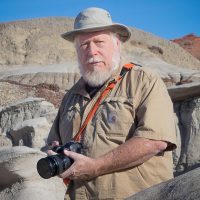Kasha-Katuwe Tent Rocks National Monument

The Kasha-Katuwe Tent Rocks National Monument is a remarkable outdoor laboratory, offering an opportunity to observe, study, and experience the geologic processes that shape natural landscapes. The National Monument, on the Pajarito Plateau in north-central New Mexico, includes a national recreation trail and ranges from 5,570 feet to 6,760 feet above sea level. It is for foot travel only, and contains two segments that provide opportunities for hiking, birdwatching, geologic observation, and plant identification.
The cone-shaped tent rock formations are the products of volcanic eruptions that occurred 6 to 7 million years ago and left pumice, ash, and tuff deposits over 1,000 feet thick. Tremendous explosions from the Jemez volcanic field spewed pyroclasts (rock fragments), while searing hot gases blasted down slopes in an incandescent avalanche called a “pyroclastic flow.”
Precariously perched on many of the tapering hoodoos are boulder caps that protect the softer pumice and tuff below. Some tents have lost their hard, resistant caprocks, and are disintegrating. While fairly uniform in shape, the tent rock formations vary in height from a few feet up to 90 feet.
What to Photograph:
The rock formations at Tent Rocks are the main attraction, formed by volcanic eruptions that occurred millions of years ago and erosion. There is also a trail through a slot canyon.
Best Time to Visit
The best times to visit are in the spring and in the fall when the temperatures are cooler. The temps can reach over 100 degrees during the summer and the sun reflecting off the sand can make it even hotter. Temps can change by 50 degrees from sunrise till noon making dressing in layers very important and be sure to take plenty of water, there is no water available.
Season/Hours
Fall/Winter (November 1 to March 10)
8:00 a.m. to 5:00 p.m. Gates close at 4:00 p.m.
Spring/Summer (March 11 to October 31)
7:00 a.m. to 7:00 p.m. Gates close at 6:00 p.m.
Holiday Closure Dates:
- Thanksgiving Day
- Christmas Eve
- Christmas Day
- New Year’s Day
- Cultural Observance (spring)
Getting There:
The National Monument includes 4,645 acres of public lands located 40 miles southwest of Santa Fe and 55 miles northeast of Albuquerque, with the most direct access from Interstate 25. From Albuquerque, take the exit for Santo Domingo/Cochiti Lake Recreation Area (Exit 259) off I-25 onto NM 22. Follow the signs on NM 22 to Cochiti Pueblo and Kasha-Katuwe Tent Rocks National Monument. Turn right off NM 22 at the Smoky Bear sign past the turquoise water tanks on the hill onto Tribal Route 92, which connects to BLM Road 1011. From the fee station, travel five miles to the National Monument’s designated parking/picnic area and trailhead.
From Santa Fe, take the Cochiti Pueblo Exit 264 off I-25 onto NM 16. Turn right off NM 16 onto NM 22, and follow the signs to Cochiti Pueblo and the National Monument.
A portion of the five-mile access road to the National Monument crosses Pueblo de Cochiti tribal land. Along with the pueblo, neighbors in the vicinity include the Santo Domingo Indians, the Jemez Indians, private landowners, the Santa Fe National Forest, and State of New Mexico. Please respect these landowners and their property.
Maps:
Interactive Google Map
Use the map + – controls to zoom in and out, click and drag the to move the map, use the Map drop-down to change to “Map”, “Satellite”, “Hybrid”, or “Terrain” views. Drag the little man icon from the upper left corner to a map location for street level view.
Cost:
Fees – Payable at entrance
- Private Vehicles – $5
- Groups:
Up to 25 individuals – $25
25-100 individuals – $100 - Schools:
No fee. Day-use permit required from BLM. Click here for more information. - Commercial Tours and Non-Profit Organizations:
Specials-use permit required from BLM. Please contact Rio Puerco Field Office at 505-761-8700 - America the Beautiful Pass – Present at entrance
- Sold and issued at entrance:
- Senior Pass – $10
- Annual Pass – $80
- Military Annual Pass – Free
- Access Pass – Free
Facilities:
- Restrooms are available
- Thanks to your donations, the Monument has purchased hand sanitizer dispensers and paper towels for all of the Monuments restrooms. These donations help to make our guests experiences more pleasant.
- RV hookups are available at Cochiti Lake Recreation Area.
- Cochiti Lake Convenience Store is approximately 7miles from the National Monument parking area and is adjacent to the Village of Cochiti Lake and the Cochiti Reservoir.
- We recommend that you bring your own drinking water, as there is no running water.
Links:
Kasha-Katuwe Tent Rocks National Monument
Location Contact Information:
-
Monument: 505-331-6259
-
Park Ranger: 505-761-8955
-
Rio Puerco Field Office
100 Sun Avenue NE
Pan American Bldg.
Suite 330
Albuquerque, NM 87109-4676
505-761-8700 - Public Lands Information Center
Nearest City or Town:
Sante Fe New Mexico
Kasha-Katuwe Tent Rocks National Monument Photo Gallery
Click Here for full page gallery
More Photographic Destinations in New Mexico:
Interactive Google Map
Use the map + – controls to zoom in and out, use the Map drop-down to change to “Map”, “Satellite”, “Hybrid”, or “Terrain” views. Drag the little man icon from the upper left corner to a map location for street level view. Click on a pushpin for more information about the Photographic Destination, then click on the title to go to the location page.
Click Here for Photographic Destinations by State






